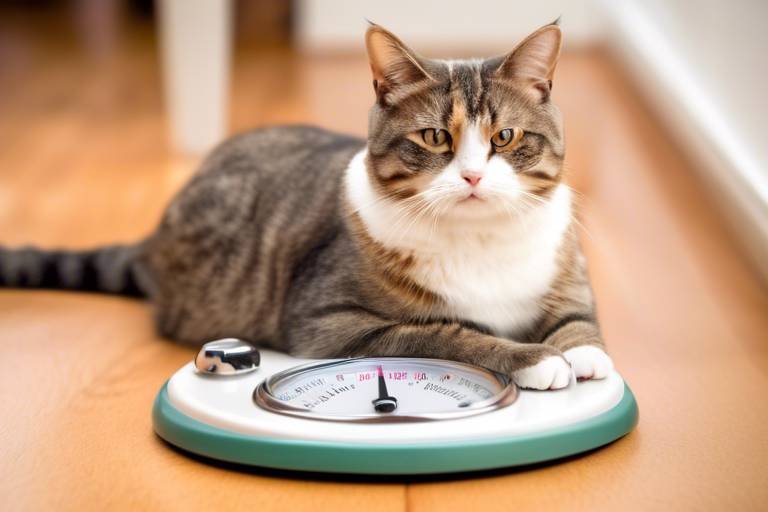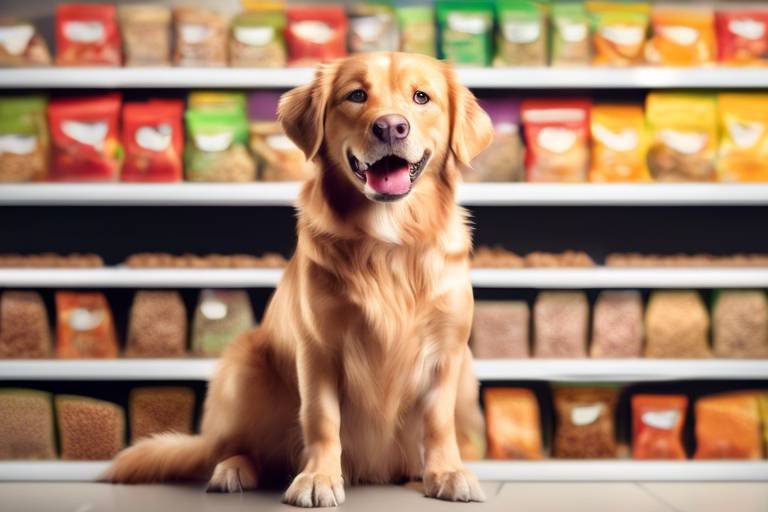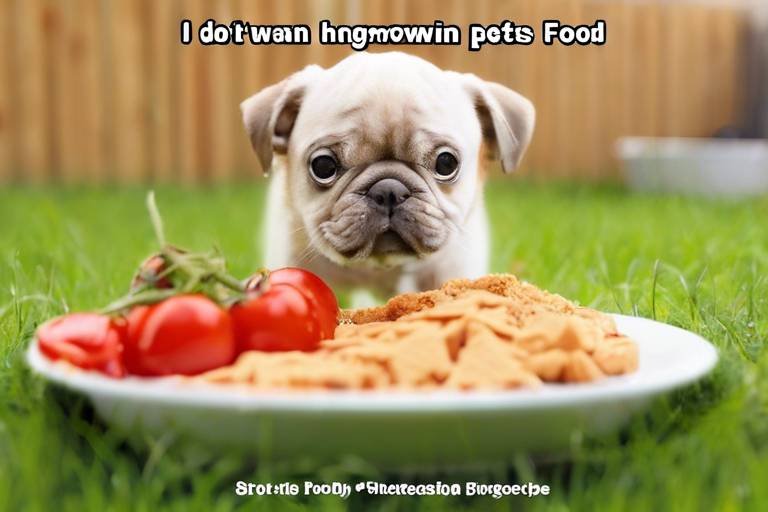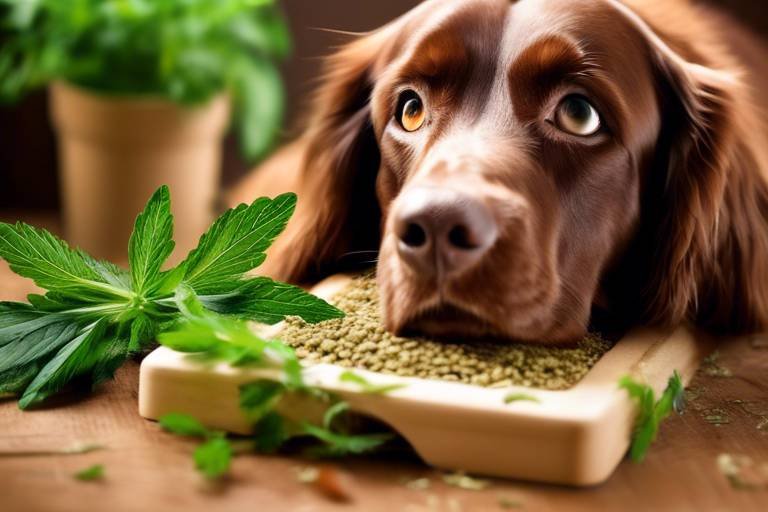How to Recognize and Treat Food Intolerances in Pets
This article explores the signs of food intolerances in pets, effective treatment strategies, and tips for managing their dietary needs to ensure their health and well-being.
Food intolerances in pets can lead to various health issues that often go unnoticed until they become severe. But what exactly are food intolerances? Unlike allergies, which trigger an immune response, food intolerances are typically related to the digestive system's inability to process certain ingredients. This can happen for various reasons, such as enzyme deficiencies or sensitivities to specific food components. The impact of food intolerances can range from mild discomfort to severe health problems, affecting your pet's overall quality of life. Just like us, pets can experience a range of symptoms that signal their bodies are struggling to cope with certain foods.
Recognizing the symptoms of food intolerances is crucial for early intervention. Pets can't tell us when they're feeling unwell, so we must be vigilant. Common signs to look out for include:
- Gastrointestinal issues
- Skin reactions
- Behavioral changes
Gastrointestinal problems are often the first indicators of food intolerances. If your pet is experiencing symptoms such as diarrhea, vomiting, or bloating, it's a clear signal that something is amiss. These symptoms can be distressing not only for your pet but also for you as a pet owner. Imagine your furry friend feeling uncomfortable and unable to enjoy their meals. It's essential to monitor their eating habits and note any changes, as these gastrointestinal issues can lead to dehydration and other serious health complications if left unaddressed.
Skin reactions can also be a sign of food intolerances. If you notice your pet scratching excessively, developing rashes, or experiencing hair loss, it may be time to reconsider their diet. These symptoms are often a result of inflammation caused by the foods they consume. Think of it as your pet's body sending out a distress signal, indicating that something in their diet isn't right. Addressing these skin issues promptly can prevent further discomfort and potential infections.
Changes in behavior can indicate discomfort from food intolerances. If your usually playful pet becomes irritable, lethargic, or starts to show a decreased appetite, it's a warning sign that shouldn't be ignored. Just like humans, pets can become moody and withdrawn when they're not feeling well. Imagine how frustrating it must be for them to feel unwell without the ability to communicate their discomfort. Being attentive to these changes can help you take action before the situation escalates.
Diagnosing food intolerances can be challenging. Veterinarians typically use a combination of methods to identify the underlying issues, including elimination diets and allergy testing. An elimination diet involves removing potential allergens from your pet's diet and then gradually reintroducing them to pinpoint the culprit. This process requires patience and careful monitoring, but it can provide invaluable insights into your pet's dietary needs.
Treating food intolerances involves dietary changes and management strategies. Once you've identified the problematic food, the next step is to implement effective treatment options that can help your pet recover and thrive. It's essential to approach this process with care and consideration for your pet's unique needs.
Elimination diets are a common method for diagnosing and treating food intolerances. To implement an elimination diet safely and effectively, follow these steps:
- Start by consulting your veterinarian for guidance.
- Choose a limited ingredient diet that excludes potential allergens.
- Monitor your pet's reaction over a period of weeks.
- Gradually reintroduce one food item at a time to identify triggers.
This method allows you to observe changes in your pet's health closely and make informed decisions about their diet.
Consulting with a veterinarian is essential for proper diagnosis and treatment. Your vet can provide professional guidance tailored to your pet's specific needs, ensuring that any dietary changes are safe and effective. Just like we seek expert advice when we're not feeling well, your pet deserves the same level of care. A knowledgeable vet can help you navigate the complexities of food intolerances, making the journey to better health smoother for both you and your furry friend.
- What are the most common food intolerances in pets? - Some common food intolerances include dairy, wheat, and certain proteins.
- How long does it take to see improvements on an elimination diet? - Improvements can often be seen within a few weeks, but it may take longer depending on the severity of the intolerance.
- Can food intolerances develop over time? - Yes, pets can develop food intolerances at any stage of life, so ongoing monitoring is important.

Understanding Food Intolerances
When it comes to our furry friends, understanding their dietary needs is crucial for their health and happiness. Food intolerances in pets can be a sneaky culprit behind various health issues, often mistaken for allergies or other ailments. But what exactly are food intolerances? In simple terms, they occur when a pet's digestive system struggles to break down certain food components, leading to uncomfortable symptoms. Unlike food allergies, which involve the immune system reacting to specific proteins, food intolerances typically result from the body's inability to properly digest certain ingredients.
Imagine your pet’s digestive system as a finely tuned engine; if one part of that engine doesn’t work correctly, the whole system can sputter and stall. Common ingredients that can cause food intolerances include grains, dairy, and certain proteins. The impact of these intolerances can range from mild discomfort to severe health issues, significantly affecting your pet's overall well-being. It’s essential to recognize that while food intolerances might not be life-threatening, they can certainly lead to a lower quality of life for your beloved companion.
Pet owners often overlook the signs of food intolerances, assuming that their pets are just experiencing a minor upset stomach or a case of the sniffles. However, the reality is that these intolerances can manifest in various ways, affecting not only the digestive system but also the skin and behavior of your pet. For instance, a pet with a food intolerance might experience chronic gastrointestinal issues, such as diarrhea or vomiting, which can lead to dehydration and weight loss if left unchecked. Additionally, skin irritations like itching or rashes can develop, making your pet uncomfortable and irritable.
Moreover, food intolerances can also lead to behavioral changes. Have you ever noticed your pet acting a bit off after mealtime? They might be feeling lethargic or irritable due to the discomfort caused by their food. It's essential to pay attention to these changes, as they can be a signal that something isn’t right with their diet.
In summary, understanding food intolerances in pets is key to ensuring their health and happiness. By recognizing the difference between intolerances and allergies, and being aware of the potential symptoms, you can take proactive steps to improve your pet's diet and overall well-being. If you suspect your pet may be suffering from a food intolerance, consulting with a veterinarian is a wise next step. They can provide guidance on the best dietary choices and management strategies tailored specifically for your furry friend.

Common Symptoms to Watch For
When it comes to our furry friends, being vigilant about their health is crucial. Just like humans, pets can experience food intolerances that can lead to a variety of uncomfortable symptoms. Recognizing these signs early can make all the difference in ensuring your pet's well-being. So, what should you be on the lookout for? Let’s dive into some of the most common symptoms that may indicate your pet is struggling with food intolerances.
First and foremost, gastrointestinal issues are often the most noticeable indicators. If your pet is suffering from food intolerances, you might observe symptoms such as:
- Diarrhea: Frequent, loose stools can be a clear sign that your pet's digestive system is reacting negatively to certain foods.
- Vomiting: If your pet is throwing up after meals, it could be their body's way of rejecting something they’ve consumed.
- Bloating: A distended abdomen can indicate discomfort and is often linked to food intolerances.
But gastrointestinal symptoms aren’t the only red flags. You should also keep an eye on your pet's skin. Skin reactions are another common sign of food intolerances. If you notice your pet scratching excessively, developing rashes, or even losing patches of fur, these could be symptoms of an underlying dietary issue. It’s as if their skin is crying out for help, signaling that something isn’t right internally.
Moreover, behavioral changes are often overlooked but can be significant indicators of food intolerances. If your usually playful pup seems unusually irritable or lethargic, it might be worth considering their diet. Changes in appetite, whether it's eating less or suddenly becoming a picky eater, can also signal discomfort. Think of it this way: if you had a stomach ache, you wouldn’t feel like going out for a meal either!
In summary, keeping a close watch on your pet's gastrointestinal health, skin condition, and behavior can provide you with vital clues about their dietary tolerances. If you notice any of these symptoms persisting, it’s essential to consult a veterinarian for further evaluation. Remember, your pet relies on you to be their advocate when it comes to their health!
Here are some common questions pet owners have regarding food intolerances:
- What is the difference between food intolerances and food allergies?
Food intolerances typically involve the digestive system and can cause discomfort without an immune response, while food allergies trigger an immune response that can lead to more severe symptoms. - Can food intolerances develop suddenly in pets?
Yes, pets can develop food intolerances at any age, even if they have been eating the same food for years without issues. - How long does it take to see improvement after changing a pet's diet?
Improvements can often be seen within a few days to weeks after eliminating the offending food from their diet.
Gastrointestinal Issues
When it comes to our furry friends, their gastrointestinal health is a window into their overall well-being. If your pet is experiencing food intolerances, gastrointestinal issues are often the first red flags that signal something might be off. Have you ever noticed your dog or cat having frequent bouts of diarrhea or vomiting? These symptoms can be distressing not only for your pet but also for you as a loving owner. Imagine your pet’s tummy as a delicate ecosystem; when the balance is disrupted by certain foods, it can lead to chaos.
Common gastrointestinal symptoms associated with food intolerances include:
- Diarrhea: This can range from mild to severe and may happen sporadically or be a constant issue. If your pet's stool is unusually loose or watery, it’s time to take notice.
- Vomiting: Occasional vomiting can happen for various reasons, but if it becomes a routine, it could indicate that your pet's system is rejecting certain foods.
- Bloating: If your pet’s stomach appears swollen or they seem uncomfortable after eating, it could be a sign of food intolerance. Bloating can lead to serious complications, so it’s essential to monitor this symptom closely.
These gastrointestinal issues can be extremely uncomfortable for your pet. Just like us, pets can feel anxious and irritable when their digestion is off. If you’ve ever had a stomach ache, you know how it can affect your mood and energy levels. Pets are no different! They may become less playful or more withdrawn, making it crucial to address these symptoms promptly.
Another thing to keep in mind is that gastrointestinal symptoms can sometimes mimic those of other health problems, making diagnosis tricky. For instance, conditions like parasites or bacterial infections can also cause similar symptoms. This overlap makes it vital to consult with your veterinarian for a thorough examination and appropriate testing.
In summary, if you notice any gastrointestinal issues in your pet, don’t brush them off as just a passing phase. Your pet’s gut health is essential, and recognizing these symptoms early can lead to effective treatment and a happier, healthier life. Remember, a healthy gut often means a happy pet!
Q: How can I tell if my pet has a food intolerance?
A: Look for symptoms such as diarrhea, vomiting, bloating, or changes in behavior. If these persist, consult your veterinarian for further evaluation.
Q: Can I treat my pet's gastrointestinal issues at home?
A: While minor issues might be manageable at home, it's best to consult a veterinarian for persistent symptoms to ensure your pet receives appropriate care.
Q: What should I do if my pet is diagnosed with a food intolerance?
A: Implement an elimination diet under the guidance of your veterinarian and monitor your pet for any changes in symptoms.
Skin Reactions
When it comes to food intolerances in pets, one of the most visible and concerning signs can manifest as . These reactions can be alarming for pet owners, as they often indicate that something is not quite right with your furry friend’s diet. Imagine your pet scratching incessantly or developing patches of irritated skin; this can be both distressing for them and puzzling for you. Skin symptoms can vary widely, but they often include itching, rashes, and even hair loss. It's crucial to recognize these signs early on, as they can significantly affect your pet's quality of life.
One common skin reaction is dermatitis, which can present itself in several forms. For instance, you might notice red, inflamed patches on your pet's skin, or perhaps they are constantly licking certain areas, leading to further irritation and potential infections. This behavior can be likened to a human who can't stop scratching an itch; the more they do it, the worse it gets. It's essential to understand that these reactions are not just minor annoyances; they can indicate underlying health issues that need to be addressed.
In some cases, the skin reactions may be accompanied by other symptoms, creating a more complex picture. For example, a pet suffering from a food intolerance might also experience gastrointestinal issues alongside skin problems. This duality can complicate diagnosis and treatment, making it imperative to observe your pet closely. While it may be tempting to treat the skin symptoms with topical ointments, it's vital to tackle the root cause—often found in their diet.
Here are some common skin symptoms to watch for:
- Itching: Excessive scratching or biting at the skin.
- Rashes: Red, inflamed patches that may weep or crust over.
- Hair Loss: Bald patches or thinning fur, often resulting from excessive grooming.
If you notice any of these symptoms, it's essential to consult with your veterinarian. They can help determine whether your pet's skin issues are related to food intolerances or if there are other factors at play. In many cases, a thorough examination and possibly allergy testing may be necessary to pinpoint the exact cause of the skin reactions.
In conclusion, being vigilant about your pet's skin health is crucial. Just like we might rush to the doctor when we notice a rash or persistent itch, your pet deserves the same level of attention. By recognizing the signs of skin reactions early, you can take proactive steps to ensure your pet's comfort and well-being. Remember, a happy pet is a healthy pet!
Behavioral Changes
When it comes to our furry friends, behavioral changes can serve as a significant red flag indicating potential food intolerances. Imagine your pet as a little detective, and their behavior is the clue you need to crack the case of their discomfort. If your usually playful pup suddenly becomes lethargic or your curious kitty starts hiding away, it might be time to investigate their diet. These shifts in behavior are often subtle yet telling signs that something isn't quite right.
Pets are creatures of habit, and any deviation from their normal behavior can be alarming. For instance, if your dog who once greeted you with joyous barks now seems irritable or uninterested in play, it’s worth considering whether their food is causing discomfort. Similarly, a cat that typically lounges around might start to show signs of restlessness or anxiety. This change can stem from the physical discomfort that food intolerances often induce, leading to a more stressed and anxious pet.
Moreover, changes in appetite can also be a clear indicator of food intolerance. Some pets may refuse to eat altogether, while others might start begging for food more frequently, only to turn their noses up at meals. This inconsistency can be frustrating for both pet owners and their companions. It’s essential to monitor these changes closely and consider keeping a journal of your pet's eating habits, energy levels, and any other behavioral shifts. This record can be invaluable for your veterinarian, providing them with detailed insight into your pet’s health.
In addition to irritability and changes in appetite, pets may also exhibit signs of discomfort through their body language. For example, a dog that frequently scratches at its ears or paws may be experiencing an itch related to food intolerances, while a cat that hunches over or avoids being touched could be feeling bloated or gassy. Keeping an eye on these physical manifestations of discomfort can help you connect the dots and take the necessary steps toward a solution.
Ultimately, understanding your pet's behavior is crucial in identifying food intolerances. If you notice any of these changes, don’t hesitate to consult your veterinarian. They can provide guidance on the next steps to take, ensuring that your furry friend gets back to their happy, playful self in no time.
- What should I do if I suspect my pet has a food intolerance? Start by monitoring their behavior and diet closely. Keeping a detailed log can help when consulting your veterinarian.
- Can food intolerances develop suddenly in pets? Yes, food intolerances can develop at any age, even if your pet has been eating the same food for years.
- Are there specific foods that commonly cause intolerances in pets? Yes, common culprits include dairy, wheat, and certain proteins like beef or chicken.
- How long does it take to see improvements after changing my pet's diet? It can take anywhere from a few days to several weeks to see noticeable improvements, depending on the severity of the intolerance.
Diagnosing Food Intolerances
Diagnosing food intolerances in pets can sometimes feel like searching for a needle in a haystack. With so many symptoms overlapping with other health issues, it’s crucial to approach the diagnosis methodically. The first step typically involves a thorough examination by a veterinarian who will take a detailed history of your pet's diet and health. They might ask questions about your pet's eating habits, recent dietary changes, and any symptoms you've observed. This information is vital in narrowing down potential triggers.
One of the most effective methods for diagnosing food intolerances is through the implementation of elimination diets. This process involves removing all potential allergens from your pet's diet for a set period, usually around 8 to 12 weeks. During this time, you’ll closely monitor your pet for any improvement in their symptoms. After the elimination phase, specific foods are gradually reintroduced one at a time. This helps pinpoint which ingredient may be causing the intolerance. To ensure accuracy, it’s essential to use a single protein and carbohydrate source that your pet has never consumed before. For example, if your dog has always eaten chicken and rice, you might try a novel protein like duck with sweet potatoes.
In addition to elimination diets, veterinarians may also recommend allergy testing. This can involve blood tests that identify specific food sensitivities. However, it’s important to note that these tests can sometimes yield false positives or negatives, leading to potential confusion. Therefore, they are often used in conjunction with an elimination diet rather than as a standalone solution. In some cases, a veterinarian may suggest a combination of diagnostic approaches to ensure a comprehensive understanding of your pet's health.
Another crucial aspect of diagnosing food intolerances is keeping a detailed food diary for your pet. Documenting what your pet eats, any treats given, and the timing of any symptoms can provide valuable insights. This diary can help both you and your veterinarian track patterns and identify possible food triggers over time.
Ultimately, diagnosing food intolerances requires patience and persistence. It’s not just about identifying the symptoms but understanding the underlying causes. With the right approach, you can help your furry friend feel their best and enjoy a happy, healthy life.
- What is the difference between food intolerance and food allergy? Food intolerance typically involves the digestive system and does not involve the immune system, while food allergies trigger an immune response.
- How long does it take to see improvements on an elimination diet? Improvements can often be seen within a few weeks, but it may take up to 12 weeks for full results.
- Can pets outgrow food intolerances? It’s possible, but many pets will have food intolerances for life. Regular consultations with your vet can help manage their dietary needs.

Effective Treatment Options
Treating food intolerances in pets is not just about switching their food; it’s a careful process that requires patience and attention. The journey to finding the right diet for your furry friend can be challenging, but understanding the available treatment options can make it a lot easier. One of the first steps in this journey is to implement elimination diets, which are essential for identifying the specific ingredients that might be causing your pet's discomfort. This method involves removing potential allergens from your pet's diet and then gradually reintroducing them one at a time to see which ones trigger a reaction.
When considering an elimination diet, it's crucial to ensure that your pet still receives all the necessary nutrients. A typical elimination diet might last anywhere from 8 to 12 weeks, and during this time, you should closely monitor your pet's symptoms. Keep in mind that this process requires strict adherence to the new diet; even a small treat containing the eliminated ingredient can skew your results. To help you understand the process better, here’s a basic outline of how to implement an elimination diet:
| Step | Action |
|---|---|
| 1 | Consult your veterinarian to determine the best elimination diet for your pet. |
| 2 | Choose a novel protein and carbohydrate source that your pet has never eaten before. |
| 3 | Feed your pet only this new diet for the entire duration of the elimination phase. |
| 4 | After the elimination period, gradually reintroduce one ingredient at a time. |
| 5 | Monitor for any adverse reactions and document your findings. |
In addition to elimination diets, it's crucial to consult a veterinarian throughout this process. A veterinarian can provide invaluable guidance and support, ensuring that your pet's dietary needs are met without compromising their health. They can also recommend specialized diets or supplements to help manage symptoms and improve overall well-being. Remember, just like us, pets can have unique dietary needs, so a one-size-fits-all approach often doesn’t work.
Moreover, some pets may require additional treatments beyond dietary changes. For instance, if your pet is experiencing severe gastrointestinal issues, your veterinarian might suggest medications to soothe their digestive system. These treatments can help alleviate discomfort while you work on identifying the root cause of the intolerance.
Finally, it’s important to create a consistent feeding routine. Pets thrive on routine, and having a set schedule can help reduce anxiety and digestive upset. Make sure to keep their feeding area clean and free from any potential contaminants. By maintaining a stable environment and following a well-thought-out treatment plan, you can help your pet recover from food intolerances and enjoy a happier, healthier life.
- What is the difference between food intolerance and food allergy in pets? Food intolerance usually involves digestive issues and does not involve the immune system, while food allergies trigger an immune response that can lead to more severe symptoms.
- How long does it take to see improvements on an elimination diet? Most pet owners notice improvements within a few weeks, but it can take up to 12 weeks for some pets to fully show positive changes.
- Can I use homemade food for my pet's elimination diet? Yes, but it’s essential to work with your veterinarian to ensure that the homemade diet is balanced and meets all of your pet's nutritional needs.
- Are there any over-the-counter solutions for food intolerances? While some supplements may help, it’s best to consult with your veterinarian before starting any new treatments.
Elimination Diets
When it comes to addressing food intolerances in pets, are often the first line of defense. Imagine this: your pet has been feeling under the weather, and you suspect that their food might be the culprit. An elimination diet is like a detective story, where you take away all the potential suspects and slowly reintroduce them one by one to see which one causes the trouble. This method not only helps in identifying the specific food that triggers your pet's intolerance but also plays a crucial role in their overall recovery.
To implement an elimination diet effectively, it’s essential to follow a systematic approach. Start by selecting a novel protein and a carbohydrate source that your pet has never eaten before. This could be something like duck and sweet potato or venison and peas. The key here is to ensure that the new diet is not contaminated with any other ingredients that could provoke a reaction. For instance, if your pet has been eating chicken and rice, switching to beef and corn won’t suffice, as they may still react to the common ingredients.
During the elimination phase, which typically lasts for about 8 to 12 weeks, it’s crucial to monitor your pet closely. Keep a detailed diary of any symptoms you observe, such as gastrointestinal issues, skin reactions, or behavioral changes. This will not only help you track improvements but also provide valuable information to your veterinarian. Remember, consistency is key! Any treats, snacks, or even flavored medications should be avoided unless they are part of the elimination diet.
Once the elimination phase is complete and your pet shows signs of improvement, it’s time for the next step: reintroduction. This phase involves gradually adding back one ingredient at a time, waiting several days between each addition to observe any potential reactions. If a symptom reappears after reintroducing a specific food, it’s a clear sign that your pet is intolerant to that ingredient. This process can be time-consuming, but it’s essential for pinpointing the exact cause of your pet's discomfort.
It's worth noting that while elimination diets can be effective, they should ideally be conducted under the supervision of a veterinarian. A vet can provide guidance on selecting the right ingredients, monitor your pet’s health throughout the process, and help you interpret the results. Remember, your pet’s health is paramount, and professional support can make all the difference in successfully managing food intolerances.
In summary, elimination diets are a powerful tool in identifying and managing food intolerances in pets. By methodically removing and reintroducing foods, you can help your furry friend find relief from discomfort and improve their quality of life.
- What is the difference between a food allergy and a food intolerance?
Food allergies involve the immune system and can cause severe reactions, while food intolerances typically result in gastrointestinal upset or other non-life-threatening symptoms.
- How long does an elimination diet take?
The elimination phase usually lasts 8 to 12 weeks, followed by a reintroduction phase that can take several weeks.
- Can I do an elimination diet at home?
While it’s possible to conduct an elimination diet at home, it’s highly recommended to do so under the guidance of a veterinarian to ensure your pet’s health and safety.
Consulting a Veterinarian
When it comes to your furry friend’s health, is not just a good idea; it’s essential. Food intolerances can manifest in various ways, and pinpointing the exact cause of your pet's discomfort can be a daunting task. Veterinarians are equipped with the knowledge and tools to help you navigate this complex issue. They can provide a thorough examination, taking into account your pet's medical history, current symptoms, and dietary habits. This is crucial because many symptoms of food intolerances can mimic other health issues, making it vital to get an accurate diagnosis.
One of the first steps your vet may recommend is an elimination diet. This involves removing potential allergens from your pet's diet for a set period, typically around 8-12 weeks, and then gradually reintroducing them one at a time. This method helps to isolate specific ingredients that may be causing the problem. However, implementing an elimination diet can be tricky, and that's where your veterinarian's guidance becomes invaluable. They can help ensure that your pet receives balanced nutrition throughout the process, preventing any deficiencies.
In addition to dietary changes, your veterinarian may suggest various diagnostic tests, such as blood tests or skin tests, to rule out food allergies and other conditions. These tests can provide insights into your pet's immune response and help identify specific triggers. It’s important to remember that while food intolerances can lead to discomfort, they are typically not life-threatening. Nevertheless, chronic issues can lead to more severe health complications if left untreated.
Another critical aspect of consulting with a veterinarian is discussing your pet’s overall health and lifestyle. Factors such as age, breed, and pre-existing health conditions can influence how food intolerances affect your pet. For instance, older pets may have a more challenging time digesting certain ingredients, making them more susceptible to intolerances. Your vet can offer tailored advice on managing these factors, ensuring your pet leads a happy and healthy life.
Finally, never underestimate the importance of open communication with your veterinarian. Share your observations, concerns, and any changes you notice in your pet's behavior or health. This information can be crucial in helping your vet make informed decisions about your pet's care. Remember, you are your pet's advocate, and your insights can lead to a more accurate diagnosis and effective treatment.
- How can I tell if my pet has a food intolerance? Look for symptoms such as gastrointestinal issues, skin reactions, or behavioral changes.
- What should I do if I suspect my pet has a food intolerance? Consult your veterinarian for a proper diagnosis and treatment plan.
- Are food intolerances the same as food allergies? No, food intolerances involve digestive issues, while allergies involve the immune system.
- Can food intolerances develop over time? Yes, pets can develop intolerances to foods they have previously tolerated.
- Is it safe to conduct an elimination diet on my own? It’s best to do this under the guidance of a veterinarian to ensure your pet’s nutritional needs are met.
Frequently Asked Questions
- What are the common signs of food intolerances in pets?
Food intolerances in pets can manifest through various symptoms. Common signs include gastrointestinal issues like diarrhea and vomiting, skin reactions such as itching and rashes, and behavioral changes like irritability or lethargy. If you notice any of these signs, it's crucial to consult with a veterinarian.
- How can I differentiate between a food intolerance and a food allergy in my pet?
While both food intolerances and allergies can cause discomfort in pets, they are different. Food allergies usually involve the immune system and can lead to severe reactions, while intolerances are often related to the digestive system and may cause milder symptoms. Observing the specific reactions your pet has can help determine the issue, but a veterinarian's input is invaluable.
- What is an elimination diet, and how does it work?
An elimination diet is a method used to identify food intolerances by removing certain ingredients from your pet's diet for a period. After a few weeks, you gradually reintroduce these ingredients one at a time to see if symptoms reappear. This process helps pinpoint which food is causing the issue, but it's essential to do this under veterinary supervision to ensure your pet's nutritional needs are met.
- How long does it take to see improvements in my pet after changing their diet?
Improvements can vary depending on the severity of the food intolerance and the specific dietary changes made. Typically, you may start to notice positive changes within a few weeks of implementing an elimination diet or switching to a hypoallergenic food. However, it's important to be patient and consistent with the new diet.
- Should I consult a veterinarian before making dietary changes for my pet?
Absolutely! Consulting a veterinarian before making any dietary changes is crucial. They can help diagnose food intolerances accurately, recommend appropriate diets, and ensure that your pet receives balanced nutrition. A professional's guidance is essential in managing your pet's health effectively.
- Can food intolerances develop suddenly in pets?
Yes, food intolerances can develop suddenly in pets, even if they've been eating the same diet for a long time. Changes in a pet's digestive system, environmental factors, or even stress can trigger new food intolerances. It's important to monitor your pet's health and behavior closely, especially if you notice any sudden changes.


















